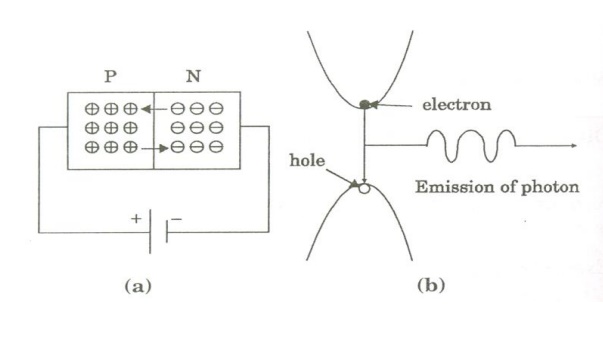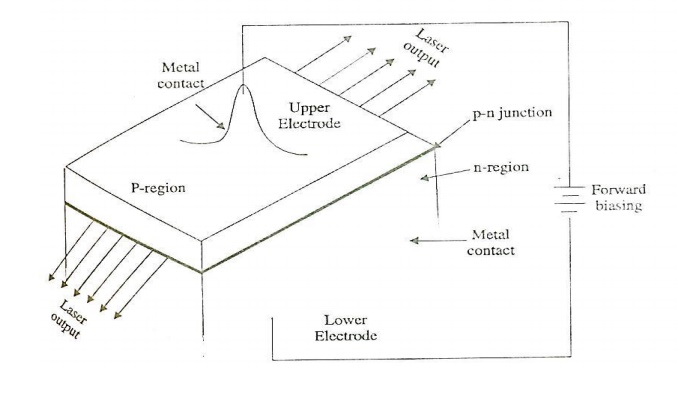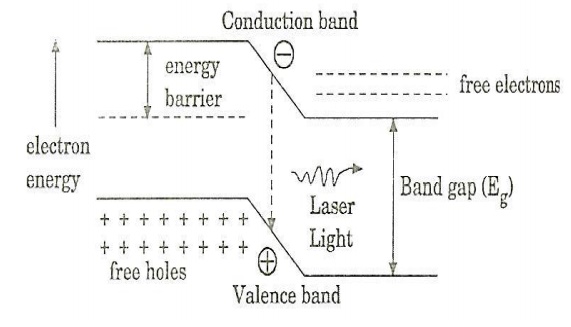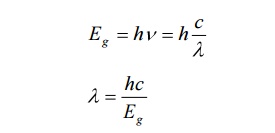Chapter: Physics : Photonics and fibre Optics
Semiconductor Diode laser: Principle, Construction, Working, Characteristics, Advantages, Disadvantages and Applications
Semiconductor Diode laser:
Definition:
It is specifically fabricated p-n junction diode. This diode emits laser light when it is forward biased.
Principle:
When a p-n junction diode is forward biased, the electrons from n – region and the holes from the p- region cross the junction and recombine with each other.
During the recombination process, the light radiation (photons) is released from a certain specified direct band gap semiconductors like Ga-As. This light radiation is known as recombination radiation.
The photon emitted during recombination stimulates other electrons and holes to recombine. As a result, stimulated emission takes place which produces laser.

Construction:
Figure shows the basic construction of semiconductor laser. The active medium is a p-n junction diode made from the single crystal of gallium arsenide. This crystal is cut in the form of a platter having thickness of 0.5μmm.

The platelet consists of two parts having an electron conductivity (n-type) and hole conductivity (p-type).
The photon emission is stimulated in a very thin layer of PN junction (in order of few microns). The electrical voltage is applied to the crystal through the electrode fixed on the upper surface.
The end faces of the junction diode are well polished and parallel to each other. They act as an optical resonator through which the emitted light comes out.
Working:
Figure shows the energy level diagram of semiconductor laser.

When the PN junction is forward biased with large applied voltage, the electrons and holes are injected into junction region in considerable concentration
The region around the junction contains a large amount of electrons in the conduction band and a large amount of holes in the valence band.
If the population density is high, a condition of population inversion is achieved. The electrons and holes recombine with each other and this recombination’s produce radiation in the form of light.
When the forward – biased voltage is increased, more and more light photons are emitted and the light production instantly becomes stronger. These photons will trigger a chain of stimulated recombination resulting in the release of photons in phase.
The photons moving at the plane of the junction travels back and forth by reflection between two sides placed parallel and opposite to each other and grow in strength.
After gaining enough strength, it gives out the laser beam of wavelength 8400o A . The wavelength of laser light is given by

Where Eg is the band gap energy in joule.
Characteristics:
1. Type: It is a solid state semiconductor laser.
2. Active medium: A PN junction diode made from single crystal of gallium arsenide is used as an active medium.
3. Pumping method: The direct conversion method is used for pumping action
4. Power output: The power output from this laser is 1mW.
5. Nature of output: The nature of output is continuous wave or pulsed output.
6. Wavelength of Output: gallium arsenide laser gives infrared radiation in the wavelength 8300 to 8500o A .
Advantages:
1. It is very small in dimension. The arrangement is simple and compact.
2. It exhibits high efficiency.
3. The laser output can be easily increased by controlling the junction current
4. It is operated with lesser power than ruby and CO2 laser.
5. It requires very little auxiliary equipment
6. It can have a continuous wave output or pulsed output.
Disadvantages:
1. It is difficult to control the mode pattern and mode structure of laser.
2. The output is usually from 5 degree to 15 degree i.e., laser beam has large divergence.
3. The purity and monochromacity are power than other types of laser
4. Threshold current density is very large (400A/mm2).
5. It has poor coherence and poor stability.
Application:
1. It is widely used in fiber optic communication
2. It is used to heal the wounds by infrared radiation
3. It is also used as a pain killer
4. It is used in laser printers and CD writing and reading.
Related Topics